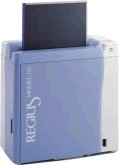Digital Xray (Digital and Captured Radiographic Systems)
Computed Radiography or (CR) allows you to retrofit your current X-Ray room which allows you to take full advantage of your current investment as well as all the benefits of Digital XRay Technology.

Now proudly Offering the Regius NANO CR System from Konica Minolta, there has never been a better time to go digital. Learn more about the Regius CR system.
It's quick, easy, convenient, affordable and available now!
Interested in moving beyond your traditional radiographic chemical
based X-ray system but confused about the differences between
Computed Radiography (CR) and Digital Radiography (DR) and where
the new technologies may fit in with your current X-Ray investment?
US Imaging can work with you to design just the right
solution for you. When thinking about Digital or Computed Radiographic systems,
consider the following comparison:
Film-based processing:
- Chemicals must be stored refreshed and disposed of periodically and properly.
- Often requires a darkroom which takes up valuable real estate.
- Film is difficult to store and takes up an enormous amount of space.
- Film images are easy to lose and cumbersome to share with patients or other physicians.
- Film is subject to over exposure or under exposure and can involve multiple retakes.
Digital Computer Radiographic Imaging:
- Compact digital format storage/archiving. Images are stored on digital media (CD-ROMS, DVD, and Network File Shares).
- Digital Images provide for easier information sharing.
- Improved diagnostics (no loss of image quality).
- Lower cost of ownership (reusable digital media).
- More efficient workflow.
When considering the move to Digital X-ray, generally speaking there are two types of systems in place to choose from.
Digital Radiography (DR):
The first, Digital Radiography (DR) refers to flat panel x-ray
detectors. A DR system is equipped with a fixed size pixilated
detector that translates the x-ray radiation directly in to an
electrical charge. That charge is sent to a processing unit which
assembles the image for you. This option can be expensive and
because the detector itself must be matched to the X-Ray equipment,
these systems are sold as an integrated solution. The advantage of
the DR is that it can produce an image immediately after the
exposure by moving the latent image directly from the detector
using the electronics integrated with the detector.
Computed Radiography (CR):
Computed Radiography (CR) refers to imaging technology using an
intermediate process - phosphor plates. The phosphor plates act
as the radiation detectors. Following x-ray exposure the plates
contained in the cassettes are loaded to a laser scanner that
reads the latent images by laser stimulation. Until recently, CR
systems were only available as large, expensive, multi-cassette
systems designed as centralized resources for radiology departments.
However, technology has changed and these systems are available
and priced so that even the small operation can enjoy the benefits
of CR.
Points to consider:
- Computer Radiography (CR) is much more forgiving than analog film systems. You do not have to worry so much about over and underexposure.
- CR is much more practical. It lets you take advantage of your investment in current radiology rooms.
- With CR, Image quality can be superior to conventional film.
- One CR system, can service multiple radiology rooms.
- The CR System itself has a compact footprint.
- With a compact system, the tech can remain in the room through the imaging process. Workflow is enhanced because the system eliminates both the walk from exam room to processor and the lines at the central system.
- Lost film problem has been solved as images can be located on disk.
- No chemical abatement issues.
Both CR and DR can offer major productivity advantages over
analog x-ray for facilities with throughputs of 30-50 patients a day.
Both also can also sharply reduce the amount of time it takes to
produce images, thus improving the overall efficiency of the
department. For more information about making the move to Digital
X-ray, give us a call and we will gladly consult with you on finding
the best solution to fit your needs.
- How does Computed Radiography (CR) work? The phosphor plates in their cassettes are
exposed to the x-ray the same way as film. During exposure the x-ray radiation
is absorbed in the phosphor plate forming a latent image. The latent images
are "extracted" from the plates when a laser beam generated inside the reader
illuminates the phosphor plate. The laser beam provides enough energy to
reverse the latent image formation process causing the plates to emit
photons of light. The photons are detected and translated into an image
that can be enhanced, processed and displayed on the monitor.
- How many times can I reuse a phosphor plate? The phosphor plate
forms and stores temporary latent images of an incoming x-ray. A plate can
be erased and reused virtually indefinitely. Plates can be used in a lighted
room and are protected from exposure to scratches, fingerprints and dirt.
- Is a Computed Radiography (CR) system easy to use? Intuitive interface of the system
allows for a short learning curve, easy access to all of the features of the system
and higher technician productivity. Typical installation and training can be done
in one day.
- What sizes of cassettes are available? Three standard size
auto-loading cassettes (14" x 17", 10" x 12" and 8" x 10") are available.
To learn more about how US Imaging LLC can help you
take advantage of the latest in Digital XRay technology, please contact us and we will
be more than happy to speak with you.
|

